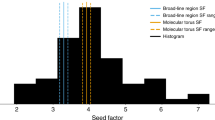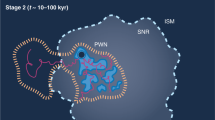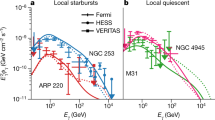Abstract
Gamma-ray line radiation at 511 keV is the signature of electron–positron annihilation. Such radiation has been known for 30 years to come from the general direction of the Galactic Centre1, but the origin of the positrons has remained a mystery. Stellar nucleosynthesis2,3,4, accreting compact objects5,6,7,8, and even the annihilation of exotic dark-matter particles9 have all been suggested. Here we report a distinct asymmetry in the 511-keV line emission coming from the inner Galactic disk (∼10–50° from the Galactic Centre). This asymmetry resembles an asymmetry in the distribution of low mass X-ray binaries with strong emission at photon energies >20 keV (‘hard’ LMXBs), indicating that they may be the dominant origin of the positrons. Although it had long been suspected that electron–positron pair plasmas may exist in X-ray binaries, it was not evident that many of the positrons could escape to lose energy and ultimately annihilate with electrons in the interstellar medium and thus lead to the emission of a narrow 511-keV line. For these models, our result implies that up to a few times 1041 positrons escape per second from a typical hard LMXB. Positron production at this level from hard LMXBs in the Galactic bulge would reduce (and possibly eliminate) the need for more exotic explanations, such as those involving dark matter.
This is a preview of subscription content, access via your institution
Access options
Subscribe to this journal
Receive 51 print issues and online access
$199.00 per year
only $3.90 per issue
Buy this article
- Purchase on Springer Link
- Instant access to full article PDF
Prices may be subject to local taxes which are calculated during checkout



Similar content being viewed by others
References
Leventhal, M., MacCallum, C. J. & Stang, P. D. Detection of 511 keV positron annihilation radiation from the galactic center direction. Astrophys. J. 225, L11–L14 (1978)
Clayton, D. D. Galaxy-Positronium origin of 476 keV galactic feature. Nature Phys. Sci. 244, 137–138 (1973)
Clayton, D. D. & Hoyle, F. Gamma-ray lines from novae. Astrophys. J. 187, L101–L103 (1974)
Prantzos, N. & Cassé, M. On the production of 26Al by Wolf-Rayet stars—Galactic yield and gamma-ray line emissivity. Astrophys. J. 307, 324–331 (1986)
Ramaty, R. & Lingenfelter, R. E. Gamma-ray line astronomy. Nature 278, 127–132 (1979)
Guessoum, N., Jean, P. & Prantzos, N. Microquasars as sources of positron annihilation radiation. Astron. Astrophys. 457, 753–762 (2006)
Cheng, K. S., Chernyshov, D. O. & Dogiel, V. A. Annihilation emission from the Galactic black hole. Astrophys. J. 645, 1138–1151 (2006)
Totani, T. A RIAF interpretation for the past higher activity of the Galactic Center black hole and the 511 kev annihilation emission. Publ. Astron. Soc. Jpn 58, 965–977 (2006)
Boehm, C., Hooper, D., Silk, J., Cassé, M. & Paul, J. MeV dark matter: Has it been detected? Phys. Rev. Lett. 92, 101301 (2004)
Knödlseder, J. et al. The all-sky distribution of 511 keV electron-positron annihilation emission. Astron. Astrophys. 441, 513–532 (2005)
Teegarden, B. J. & Watanabe, K. A comprehensive search for gamma-ray lines in the first year of data from the INTEGRAL spectrometer. Astrophys. J. 646, 965–981 (2006)
De Cesare, G. et al. INTEGRAL/IBIS search for e-e+ annihilation radiation from the galactic center region. Adv. Space Res. 38, 1457–1460 (2006)
Weidenspointner, G. et al. The sky distribution of positronium annihilation continuum emission measured with SPI/INTEGRAL. Astron. Astrophys. 450, 1013–1021 (2006)
Milne, P. A., Kurfess, P. A., Kinzer, R. L., Leising, M. D. & Dixon, D. D. in The Fifth Compton Symposium. (eds McConnell, M. L. & Ryan, J. M.) 21–30 (AIP Conf. Proc. Vol. 510, American Institute of Physics, Melville, 2000)
Kinzer, R. L. et al. Positron annihilation radiation from the inner galaxy. Astrophys. J. 559, 282–295 (2001)
Weidenspointner, G. et al. The sky distribution of 511 keV positron annihilation line emission as measured with INTEGRAL/SPI. In Proceedings of 6th INTEGRAL Workshop (ESA SP-622, ESA Publications Division, Noordwijk, in the press); preprint at 〈http://arxiv.org/abs/astro-ph/0702621〉 (2007)
Gehrels, N. et al. GRIS observations of positron annihilation radiation from the Galactic center. Astrophys. J. 375, L13–L16 (1991)
Benjamin, R. A. et al. First GLIMPSE results on the stellar structure of the Galaxy. Astrophys. J. 630, L149–L152 (2005)
Knödlseder, J. et al. A multiwavelength comparison of COMPTEL 1.8 MeV 26Al data. Astron. Astrophys. 344, 68–82 (1999)
Plüschke, S. et al. in Proceedings of the Fourth INTEGRAL Workshop (ed. Battrick, B.) 55–58 (ESA SP-459, European Space Agency, ESA Publications Division, Noordwijk, 2001)
Diehl, R. et al. 26Al in the inner Galaxy. Large-scale spectral characteristics derived with SPI/INTEGRAL. Astron. Astrophys. 449, 1025–1031 (2006)
Jean, P. et al. Spectral analysis of the Galactic e+e- annihilation emission. Astron. Astrophys. 445, 579–589 (2006)
Gillard, W., Jean, P., Marcowith, A. & Ferrière, K. Transport of positrons in the interstellar medium. in Proceedings of 6th INTEGRAL Workshop (ESA SP-622, ESA Publications Division, Noordwijk, in the press); preprint at 〈http://arxiv.org/abs/astro-ph/0702158〉 (2007)
Bird, A. J. et al. The 3rd IBIS/ISGRI soft gamma-ray survey catalog. Astrophys. J. Suppl. Ser. 170, 175–186 (2007)
Bazzano, A. et al. INTEGRAL IBIS census of the sky beyond 100keV. Astrophys. J. 649, L9–L12 (2006)
Grimm, H.-J., Gilfanov, M. & Sunyaev, R. The Milky Way in X-rays for an outside observer. Astron. Astrophys. 391, 923–944 (2002)
Schanne, S., Cassé, M., Sizun, P., Cordier, B. & Paul, J. Type Ia supernova rate in the Galactic Center region. In Proceedings of 6th INTEGRAL Workshop (ESA SP-622, ESA Publications Division, Noordwijk, in the press); preprint at 〈http://arxiv.org/abs/astro-ph/0609566〉 (2007)
Knödlseder, J. et al. Imaging the gamma-ray sky with SPI aboard INTEGRAL. in Proceedings of 6th INTEGRAL Workshop (ESA SP-622, ESA Publications Division, Noordwijk, in the press); preprint at 〈http://arxiv.org/abs/astro-ph/0712.1668〉 (2007)
Robin, A. C., Reylé, C., Derrière, S. & Picaud, S. A synthetic view on structure and evolution of the Milky Way. Astron. Astrophys. 409, 523–540 (2003)
Acknowledgements
This work is based on observations with INTEGRAL, an ESA project with instruments and science data centre funded by ESA member states (especially the PI countries: Denmark, France, Germany, Italy, Switzerland, Spain), Czech Republic and Poland, and with the participation of Russia and the USA. A.W.S. is supported by the German Bundesministerium für Bildung, Wissenschaft, Forschung und Technologie (BMBF/DLR).
Author Contributions G.W. led the work and performed the main analysis. G.S. was involved in editing and some of the statistical analysis and P.J. with the background modelling and spectral analysis. J.K. was responsible for the modelling and fitting software used. P.v.B., R.D., B.C., S.S. and C.W. critically discussed the analysis methods and the scientific interpretation. G.B. made general scientific contributions and shared his historical memory. A.W.S. provided critical evaluation of the manuscript and pointed out relevant literature. All the authors discussed the results and commented on the manuscript.
Author information
Authors and Affiliations
Corresponding author
Supplementary information
Supplementary Information
This file contains Supplementary Notes concerning the SPI instrument, the observations used, data analysis techniques, definitions of sky models, the statistical determination of the inner disk flux ratio and its significance, the statistical comparison with the distribution of observed X-ray binaries, and comparisons to previous measurements. Also included there are the associated Supplementary Figures 1-4 with Legends; Supplementary Table 1, providing fit results for different models, and additional references. (PDF 1087 kb)
Rights and permissions
About this article
Cite this article
Weidenspointner, G., Skinner, G., Jean, P. et al. An asymmetric distribution of positrons in the Galactic disk revealed by γ-rays. Nature 451, 159–162 (2008). https://doi.org/10.1038/nature06490
Received:
Accepted:
Issue Date:
DOI: https://doi.org/10.1038/nature06490
This article is cited by
-
Positronium Negative Ion Embedded in Non-ideal Classical Plasmas: Doubly Excited Singlet S States
Few-Body Systems (2024)
-
The Positron Puzzle
Astrophysics and Space Science (2023)
-
Understanding the origin of the positron annihilation line and the physics of supernova explosions
Experimental Astronomy (2021)
-
Gamma-ray astrophysics in the MeV range
Experimental Astronomy (2021)
-
Properties of the Positronium Negative Ion Embedded in Non-ideal Classical Plasmas
Few-Body Systems (2020)
Comments
By submitting a comment you agree to abide by our Terms and Community Guidelines. If you find something abusive or that does not comply with our terms or guidelines please flag it as inappropriate.



